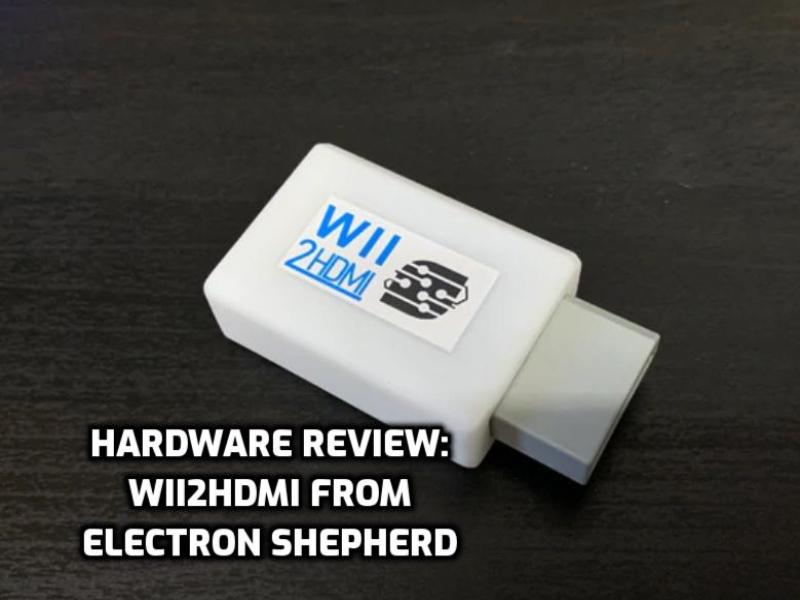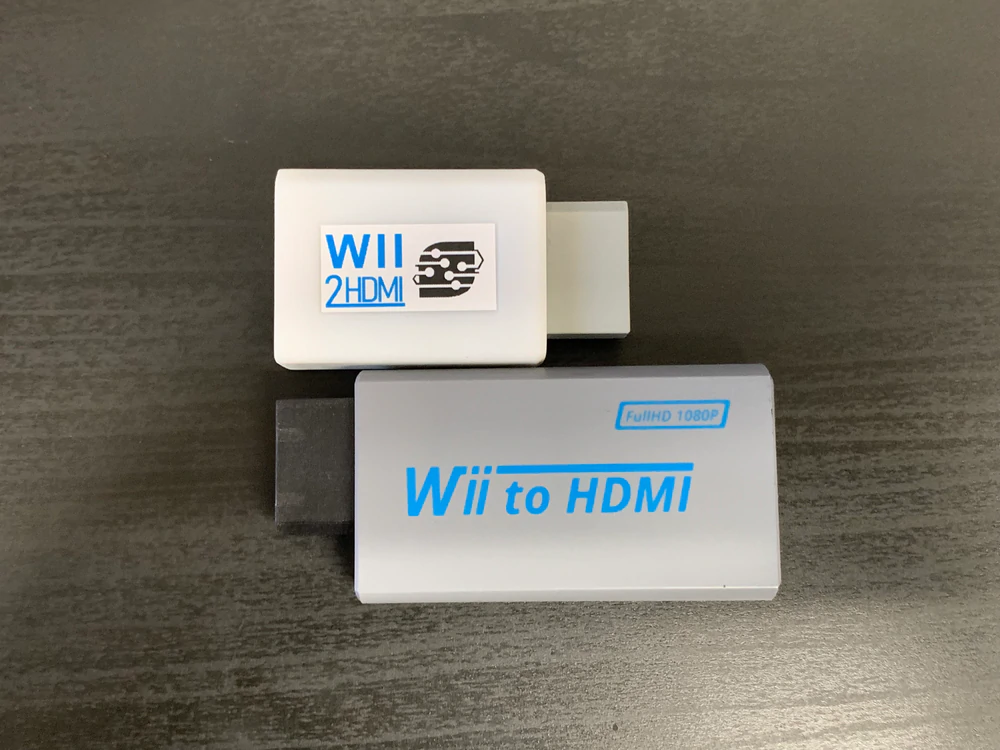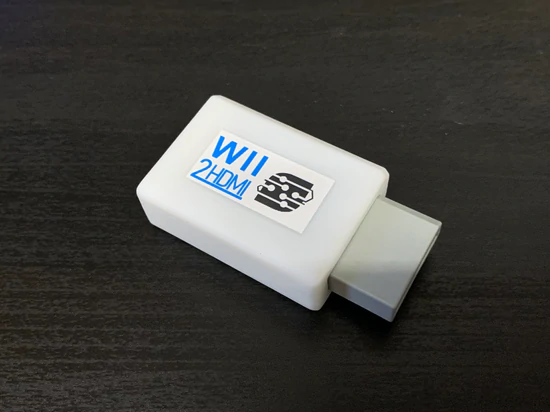Electron Shepherd are not a new company. I’m not sure how long they’ve been around, but they look to be dabbling in the gaming space. I think that this is a great idea since they have creative products/solutions. We all like having more options, especially in the gaming space. Today, we’re looking at a product that is here to combat the existing mass produced Wii HDMI adapter. It’s called the Wii2HDMI adapter and I want to talk about it. Let’s go!
Unboxing Video:
Description:
This tiny, power-packed module takes in the native Component video and analog audio output from the Wii and outputs a crisp HDMI video stream. This module utilizes a fully custom PCB with a higher quality, next generation IC compared to what is typically used on the widely available Wii2HDMI and VGA2HDMI modules that are readily available online. The low quality construction of those other modules often leads to video and audio with interference that inhibits enjoyable gameplay. If you are not happy with those modules, then you will absolutely be happy with these.
Features:
This module efficiently supports the 480i/p resolutions that are default to the Wii. This module is able to support all of the following resolutions although they are not typically achievable outputs from the Wii: 480i/p, 576i/p, 720p25/30/50/60, 1080i50/60, 1080p24/25/30/50/60.
Pros:
- Build Quality. I don’t have one of the Chinese ‘Wii to HDMI’ adapters, only pictures. But you can tell that the Wii2HDMI is smaller. Not just in length but also in width. If you plug it in, it takes a little force. Once it’s plugged in, it snugly holds on the back of the Wii. The Wii2HDMI will come out with, but as I said, with a bit of force. It’s twice as difficult to pull out the HDMI cord from the other end though. However, I don’t find this to be a downside. I think the fact that someone cannot accidentally unplug the cord is immensely appealing for a product like this.
.
I love the color of it, I feel that Electron Shepherd has color-matched the Wii quite well. The same goes for the shape of it. The body looks like a miniature Wii. And as far as I can tell, it looks to be 3D printed, likely with a PLA filament. Funnily enough, I intentionally tried to break it and couldn’t find a way to hurt or crack the shell. Not that anything like that would ever happen to this, but I love to really make sure of the longevity of a product that I’m reviewing.
. - Visual Fidelity. This hardware supports the default resolutions that the Wii comes with. You’ll see 480i as an option, which is interlaced. Or you’ll have 480p as an option, which is progressive. I’ll show off these resolutions in videos at the end of the article for comparison. But to my own eyes, the output looks better in 480p. In the video, you’ll likely see what I see. The image in 480i is a bit softer but still clearer than running video through composite. This is closer to the way that component appears to me. When you run the video in 480p mode, you’ll see a bit more of the sharpness. Some may not prefer the tiny little jaggies, but honestly, it feels more modern to me that way.
.
Additionally, you will still have the choice if you want to have the Wii in 4:3 (square) or 16:9 (rectangle). Personally, I left it on 16:9 and 480p and I had a great time playing my Wii games. I also noticed that using this cable versus component that the colors appeared to be more appealing/accurate. I say accurate because I feel like this presents the image the way it was intended to look. The colors are an incredibly small shift and it’s something that I didn’t dwell on. I realized that some games improved while others stayed the same. This is where I’d say your mileage may vary.
.
In my testing, I didn’t see any interference on the screen. I think you also need to remember that some devices allow for and even introduce interference with the signal. But in the instance of the Wii2HDMI, that’s not what I experienced. However, it’s not just the device that needs to be quality. You have to supplement it with a quality HDMI cord that is well shielded as well. There are definitely some poopy ones that are wicked thin and that’s no bueno. However, a nice, solid HDMI cord especially with a gold plated plug is going to be the best-case scenario here. You can further reduce the chance of interference with a shorter video cable. Move the console closer to the TV and use the shortest HDMI cable you can and you’ll have the cleanest image.
. - Compatibility. You may think this is obvious, but I still want to quickly confirm the devices that it can work on. All standard-shaped Wii models are covered with the Wii2HDMI. However, the red and black Wii Mini does not work with this. Let me repeat that and then make a clarification. You should not buy the Wii2HDMI if all that you own is a Wii Mini. It’s not any fault of Electron Shepherd, the Wii Mini was designed this way. I’m not even entirely sure that you can hard mod the system to have HDMI out. Nintendo removed the 480i and 480p options, sorry Wii Mini owners. Don’t be sad, it’s not your fault either!
.
Now, I want to go in a different direction with my compatibility point. So if you watched my unboxing video up top, you’ll see that I made a blasphemous point. If you have the GCHD MK-II from EON, you’ll already know where I’m headed. The GCHD is an HDMI adapter for the DOL-001 models of Gamecube. They have a Digital Port for higher resolution video output. The GCHD plugs into that and it plugs into the standard video out port. So instead of just plugging that hole up, they have it as a passthrough to that port. They give us a Wii video out port on the device. So I just want you all to know that this indeed does work with that.
.
All in all, you can be happy if you want two signals to come out of the back of your Gamecube. But that’s not all that I discovered when using this on the GCHD MK-II. What I found to be the craziest of all is the fact that I could still force Progressive Scan. The console recognized the signal and accepted me holding B and enabling it. Or even forcing it with Swiss to give output in that resolution!
.
I want to be clear here; I’m not sure if that’s just a fluke. Maybe you can always hold B and choose Progressive Scan even when using composite. Maybe it can’t detect which cable you’re using and just gives the option no matter what. All that I know is that’s cool as heck and the videos below will show my results. I will say that there was a bit of noise on this secondary signal. That noise shows up when using composite too. So remember when using it, it will look a little better than composite, and count your blessings you don’t have to use composite!
- Use Cases. Having this Wii2HDMI adapter opens up a whole new possibility for portability. Sure, you can absolutely buy one just to use on your TVs at home, but I mean more than that. With the Wii2HDMI I see a future where you could have greater portability. You can play a Wii anywhere you wanted (that had a power source). Just pop it in a backpack with a portable monitor and that’s it. Previously, you would’ve only been able to do that if you had a monitor with RCA or Component inputs. And those monitors were large and couldn’t hold charge. Modern portable monitors lend themselves very well to this idea!
.
The next thought I had was that streaming from the Wii now becomes a lot less cumbersome. Before you’d have to have an RCA to HDMI adapter to your capture device, or a capture device that took RCA, or component capture card, or component cables to OSSC and then the capture card. Now it’s just HDMI into the capture card. You’ll find that you still have an audio source, since HDMI handles audio as well.
.
As I mentioned in the previous topic, this works with EON’s GCHD MK-II HDMI adapter for Gamecube. There are several use cases if you intend on buying this just for that. You can now stream Gamecube homebrew and Gamecube games straight to your PC. This also means that you can play those games at the same time on a screen that doesn’t introduce lag. For the uninitiated, some capture cards introduce lag and you cannot play on your PC screen to stream. You’ll also be able to have better split-screen action if you use this with the GCHD. Instead of you and other friends all huddling around one TV, this makes it so that you can have two screens going at once. The game goes for if you’re running tournaments at a local event. Less people around one screen is useful.
.
Finally, the Wii2HDMI is a step forward for people who care about cord management. This goes for both Wii and Gamecube, naturally. Just think of how much cleaner and easier it will be to not deal with a thick cord that ends in 3-5 little plugs ala composite or component. Even better than that, I’ve never seen a first or third-party video cable for the Wii that is black. Now you can have a black HDMI cord that disappears into the darkness behind your TV and such. One of my personal pet peeves are light colored cables and cords. They stick out like a sore thumb, peeking from behind the devices.
.
Cons:
- Colors. I’d like to see a few more color options to match other Wiis. Black and red would be two color options I would expect since they were the other two common colors. If they wanted to really sell some units, they’d include that weird Walmart baby blue color as an option as well! I’m not mad at white as a color to start with. I just hope that Electron Shepherd expands the color choices if they end up moving enough units to warrant such an endeavor.
. - Audio. A lot of people will get this with the intent of having the audio on one cable. Those cable management aficionados, for instance. Some people, on the other hand, like having a dedicated audio cable separate from video. Having a separate audio breakout cable is more affordable when hooking up surround sound without a tuner. I know from pictures that the ‘Wii to HDMI’ has a separated 3.5mm audio jack. I would love to see something like that added in the long run or even better, a SPDIF/TOSLink/Optical audio jack next to the HDMI port.
.
As of now, I have a few existing options. One is to split the HDMI signal and have one go to the TV and the other to an HDMI to an audio adapter to my surround. The other is to have one super duper long 3.5mm auxiliary cord go from the audio out jack on my TV to an RCA adapter to my surround. The last one is to simply use TV speakers only, but that is depressing and I WON’T DO IT! *stomps feet*
Final Thoughts:
I really love this device overall. It was a great reason to start playing the Wii again. I think a single cord option compared to a breakout cable, like component, is the best. This is especially true when it comes to more modern televisions. To my mind, this is a better overall idea than having a cumbersome component cable setup. As mentioned, I didn’t buy a Chinese Wii HDMI adapter, so, unfortunately, I don’t have one to compare it to. If you want a video between the Chinese option and Wii2HDMI, reach out to me if you have one I can borrow. You can reach out on Twitter or comment on any of my Wii2HDMI videos. Additionally, I also did not have a Wii that has been modded to have HDMI out. Otherwise, I would’ve gladly have compared the two.
.
Finally, I’d like to say, I really want to see the Playstation/Playstation 2 get this same treatment. There is also a Chinese option, but it’s entirely awful according to the videos I’ve seen. I hope Electron Shepherd can crack the case on Sony’s flagship consoles!



